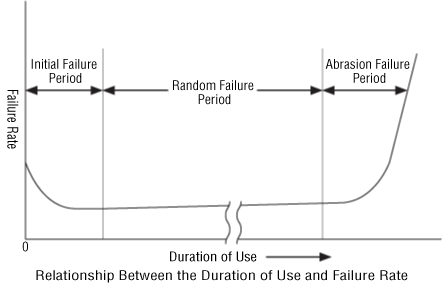Service Life: Relationship Between the Duration of Use and Failure Rate
Generally, the failure rate of parts relative to the duration of use fits the pattern of 3 states: initial failure, random failure and wear-out failure, as shown in the figure below.

The risks of initial failures are eliminated in the manufacturing and inspection processes, but random failures are sudden failures that occur randomly and unexpectedly during the durable life of the product before wear progresses. Therefore, it is difficult to provide technical measures against random failures, and the only measure available presently is to predict occurrences based on statistical data.
Wear-out failures occur towards the end of the product's durable life as a result of deterioration and wear. The rate of wear-out failure increases dramatically after a certain period. Replacing certain parts at this point will provide an effective means for preventive maintenance.
(Excerpt From "Recommendation for Periodic Inspection of General Inverters" by the Japan Electrical Manufacturers' Association)